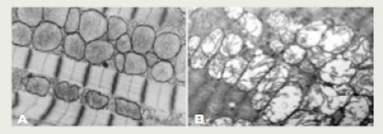
Concept explainers
Mitochondrial Abnormalities in Tetralogy of Fallot Tetralogy of Fallot (TF) is a genetic disorder in which heart malformations result in abnormal blood circulation, so oxygen does not reach body cells as it should. With insufficient oxygen to accept electrons at the end of miotchondrial electron transfer chains, too many free radicals form. This damages the mitochondria—and the cells. In 2004, Sarah Kuruvilla studied mitochondria in the heart muscle of TF patients. Some of her results are shown in FIGURE 7.13.

| Patient (age) | SPO2(%) | Mitochondrial Abnormalities in TF | |||
| Number | Shape | Size | Broken | ||
| 1(5) | 55 | + | + | − | − |
| 2(3) | 69 | + | + | − | − |
| 3(22) | 72 | + | + | − | − |
| 4(2) | 74 | + | + | − | − |
| 5(3) | 76 | + | + | − | + |
| 6(2.5) | 78 | + | + | − | + |
| 7(1) | 79 | + | + | − | − |
| 8(12) | 80 | + | − | + | − |
| 9(4) | 80 | + | + | − | − |
| 10(B) | 83 | + | − | + | − |
| 11(20) | 85 | + | + | − | − |
| 12(2.5) | 89 | + | − | + | − |
FIGURE 7.13 Mitochondrial changes in tetralogy of Fallot (TF).
(A) Normal heart muscle. Many mitochondria between the fibers provide muscle cells with ATP for contraction. (B) Heart muscle from a person with TF has swollen, broken mitochondria.
(C) Types of mitochondrial abnormalities in TF patients. SPO2 is oxygen saturation of the blood. A normal value of SPO2 is 96%. Abnormalities are marked +.
3. Can you make any correlations between blood oxygen content and mitochondrial abnormalities in these patients?
Want to see the full answer?
Check out a sample textbook solution
Chapter 7 Solutions
Biology: The Unity and Diversity of Life (MindTap Course List)
- The following table is from Kumar et. al. Highly Selective Dopamine D3 Receptor (DR) Antagonists and Partial Agonists Based on Eticlopride and the D3R Crystal Structure: New Leads for Opioid Dependence Treatment. J. Med Chem 2016.arrow_forwardThe following figure is from Caterina et al. The capsaicin receptor: a heat activated ion channel in the pain pathway. Nature, 1997. Black boxes indicate capsaicin, white circles indicate resinferatoxin. You are a chef in a fancy new science-themed restaurant. You have a recipe that calls for 1 teaspoon of resinferatoxin, but you feel uncomfortable serving foods with "toxins" in them. How much capsaicin could you substitute instead?arrow_forwardWhat protein is necessary for packaging acetylcholine into synaptic vesicles?arrow_forward
- 1. Match each vocabulary term to its best descriptor A. affinity B. efficacy C. inert D. mimic E. how drugs move through body F. how drugs bind Kd Bmax Agonist Antagonist Pharmacokinetics Pharmacodynamicsarrow_forward50 mg dose of a drug is given orally to a patient. The bioavailability of the drug is 0.2. What is the volume of distribution of the drug if the plasma concentration is 1 mg/L? Be sure to provide units.arrow_forwardDetermine Kd and Bmax from the following Scatchard plot. Make sure to include units.arrow_forward
- Choose a catecholamine neurotransmitter and describe/draw the components of the synapse important for its signaling including synthesis, packaging into vesicles, receptors, transporters/degradative enzymes. Describe 2 drugs that can act on this system.arrow_forwardThe following figure is from Caterina et al. The capsaicin receptor: a heat activated ion channel in the pain pathway. Nature, 1997. Black boxes indicate capsaicin, white circles indicate resinferatoxin. a) Which has a higher potency? b) Which is has a higher efficacy? c) What is the approximate Kd of capsaicin in uM? (you can round to the nearest power of 10)arrow_forwardWhat is the rate-limiting-step for serotonin synthesis?arrow_forward
 BiochemistryBiochemistryISBN:9781305577206Author:Reginald H. Garrett, Charles M. GrishamPublisher:Cengage Learning
BiochemistryBiochemistryISBN:9781305577206Author:Reginald H. Garrett, Charles M. GrishamPublisher:Cengage Learning Human Physiology: From Cells to Systems (MindTap ...BiologyISBN:9781285866932Author:Lauralee SherwoodPublisher:Cengage Learning
Human Physiology: From Cells to Systems (MindTap ...BiologyISBN:9781285866932Author:Lauralee SherwoodPublisher:Cengage Learning Biology: The Unity and Diversity of Life (MindTap...BiologyISBN:9781305073951Author:Cecie Starr, Ralph Taggart, Christine Evers, Lisa StarrPublisher:Cengage Learning
Biology: The Unity and Diversity of Life (MindTap...BiologyISBN:9781305073951Author:Cecie Starr, Ralph Taggart, Christine Evers, Lisa StarrPublisher:Cengage Learning Biology: The Dynamic Science (MindTap Course List)BiologyISBN:9781305389892Author:Peter J. Russell, Paul E. Hertz, Beverly McMillanPublisher:Cengage Learning
Biology: The Dynamic Science (MindTap Course List)BiologyISBN:9781305389892Author:Peter J. Russell, Paul E. Hertz, Beverly McMillanPublisher:Cengage Learning Anatomy & PhysiologyBiologyISBN:9781938168130Author:Kelly A. Young, James A. Wise, Peter DeSaix, Dean H. Kruse, Brandon Poe, Eddie Johnson, Jody E. Johnson, Oksana Korol, J. Gordon Betts, Mark WomblePublisher:OpenStax College
Anatomy & PhysiologyBiologyISBN:9781938168130Author:Kelly A. Young, James A. Wise, Peter DeSaix, Dean H. Kruse, Brandon Poe, Eddie Johnson, Jody E. Johnson, Oksana Korol, J. Gordon Betts, Mark WomblePublisher:OpenStax College Biology (MindTap Course List)BiologyISBN:9781337392938Author:Eldra Solomon, Charles Martin, Diana W. Martin, Linda R. BergPublisher:Cengage Learning
Biology (MindTap Course List)BiologyISBN:9781337392938Author:Eldra Solomon, Charles Martin, Diana W. Martin, Linda R. BergPublisher:Cengage Learning





